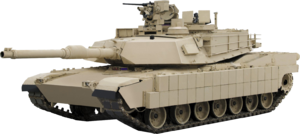
Military vehicles are commonly armoured (or armored; see spelling differences) to withstand the impact of shrapnel, bullets, shells, rockets, and missiles, protecting the personnel inside from enemy fire. Such vehicles include armoured fighting vehicles like tanks, aircraft, and ships.
Civilian vehicles may also be armoured. These vehicles include cars used by officials (e.g., presidential limousines), reporters and others in conflict zones or where violent crime is common. Civilian armoured cars are also routinely used by security firms to carry money or valuables to reduce the risk of highway robbery or the hijacking of the cargo.
Armour may also be used in vehicles to protect from threats other than a deliberate attack. Some spacecraft are equipped with specialised armour to protect them against impacts from micrometeoroids or fragments of space debris. Modern aircraft powered by jet engines usually have them fitted with a sort of armour in the form of an aramid composite kevlar bandage around the fan casing or debris containment walls built into the casing of their gas turbine engines to prevent injuries or airframe damage should the fan, compressor, or turbine blades break free.[1]
The design and purpose of the vehicle determines the amount of armour plating carried, as the plating is often very heavy and excessive amounts of armour restrict mobility. In order to decrease this problem, some new materials (nanomaterials) and material compositions are being researched which include buckypaper,[2] and aluminium foam armour plates.[3]
- ^ "Containment Device: Transport Armor: Pinnacle Armor – Body Armor and Armoring Products". Pinnacle Armor. Archived from the original on September 28, 2011. Retrieved 2012-01-29.
- ^ "Buckypaper armour". Slipperybrick.com. 2008-10-19. Archived from the original on 2012-02-17. Retrieved 2012-01-29.
- ^ "Lightweight aluminum foam armour plates". Ntnu.no. Archived from the original on 2012-09-05. Retrieved 2012-01-29.